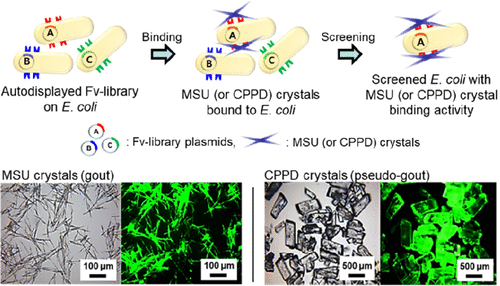- Title
- [2021] [Jae-Chul Pyun ]Screening of Fv Antibodies with Specific Binding Activities to Monosodium Urate and Calcium
- Date
- 2021.09.28
- Writer
- AMRC
- 게시글 내용
-
Screening of Fv Antibodies with Specific Binding Activities to Monosodium Urate and Calcium Pyrophosphate Dihydrate Crystals for the Diagnosis of Gout and Pseudogout
Abstract
To date, medical diagnosis of gout and pseudogout has been performed by observing the crystals in the joint fluid of patients under a polarized microscope. Conventional diagnostic methods using a polarized microscope have disadvantages, such as time-consuming analysis, a high false negative rate, and difficulty in distinguishing gout with monosodium urate (MSU) crystals and pseudogout with calcium pyrophosphate dihydrate (CPPD) crystals in synovial fluids. In this study, a chromogenic assay for the diagnosis of gout and pseudogout, without the requirement of a polarized microscope and trained experts, was proposed using Fv antibodies with specific binding activities to MSU and CPPD crystals. The IgG VH chain Fv library with randomized complementarity-determining region 3 (CDR3) region was expressed on the outer membrane of Escherichia coli using autodisplay technology. The target Fv antibodies with binding activity to MSU and CPPD crystals were screened from the autodisplayed Fv library on the E. coli outer membrane, and five clones were selected. On the basis of the binding properties of the screened Fv antibodies, peptides with the selected clone of amino acid sequences of the CDR3 region (15 residues) were chemically synthesized. The binding properties of the synthetic peptides with amino acid sequences of CDR3 regions from the selected clones were analyzed using fluorescence imaging and flow cytometry, and the affinity constants (Kd) of each peptide for binding to MSU and CPPD crystals were calculated by fitting based on the isotherm model. A chromogenic assay configuration for gout and pseudogout was developed using synthetic peptides. In this chromogenic assay, synthetic peptides labeled with biotin and streptavidin–horseradish peroxidase (HRP) complex were used, and crystal detection was possible using a chromogenic reaction between HRP and a chromogenic substrate (TMB). Finally, gout and pseudogout were diagnosed by detecting MSU and CPPD crystals in the synovial fluid in the concentration range of 0–300 μg/mL.

paper information
ACS Appl. Bio Mater. 2021, 4, 4, 3388–3397
Received 31 December 2020, Accepted 8 March 2021, Published online 6 April 2021, Published inissue 19 April 2021
Authors: Ji-Hong Bong, Soo Jeong Lee, Moon-Ju Kim, Jeong Soo Sung, Misu Lee, Min-Jung Kang, Jungsik Song,
Joachim Jose, Jae-Chul Pyun



